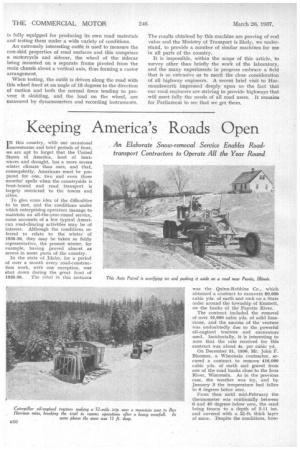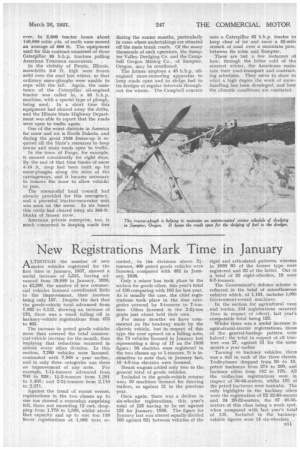Keeping America's Roads Open
Page 44

Page 45

If you've noticed an error in this article please click here to report it so we can fix it.
An Elaborate Snow-removal Service Enables Roadtransport Contractors to Operate All the Year Round
I N this country, with our occasional
snowstorms and brief periods of frost, we are apt to forget that the United States of America, land of heatwaves and drought, has a more severe winter climate than ours, and that, consequently, Americans must be prepared for one, two and even three months' spells when the countryside is frost-bound and road transport is largely restricted to the towns and cities.
To give some idea of the difficulties to be met, and the conditions under which enterprising operators manage to maintain an all-the-year-round service, some accounts of a few typical American road-clearing activities may be of interest. Although the conditions referred to relate to the winter of 1935-36, they may be taken as fairly representative, the present winter, for example, having proved almost as severe in some parts of the country.
In the state of Idaho, for a period of over a month every road-construction work, with one exception, was shut down during the great frost of 1935-36. The rebel in this instance
was the Quinn-Robbins Co., which obtained a contract to excavate 80,000 cubic yds. of earth and rock on a State order around the township of Emmett, on -the banks of the Payette River.
The contract included the removal of over 10,000 cubic yds. of solid limestone, and the success of the venture was undoubtedly due to the powerful oil-engined tractors and excavators used. Incidentally, it is interesting to note that the rate received for this contract was about 4s, per cubic yd.
On December 31, 1936, Mr. John F. Bloomer, a Wisconsin contractor, secured a contract to remove, 416,000 cubic yds. of earth and gravel from one of the road banks close to the Iron River, Wisconsin. As in the previous case, the weather was icy, and by January 3 the temperature had fallen to 6 degrees below zero.
From then until mid-February the thermometer was continually between 6 and 40 degrees below zero, the sand being frozen to a depth of 2-11 ins. and covered with a 2i-ft. thick layer of snow. Despite the conditions, how
ever, in 2,000 tractor hours about 140,000 cubic yds. of earth were moved an average of 600 ft. The equipment used for this contract consisted of three Caterpillar 95 b.h.p. tractors pulling American Tourneau excavators.
In the vicinity of Peoria, Illinois, snowdrifts 3-6 ft. high were frozen solid over the road last winter, so that ordinary snow-ploughs were unable to cope with the fall. Again, the assistance of the Caterpillar oil-engined tractor was called in, a 95 b.h.p. machine, with a special type of plough, being used. In a short time thil equipment had cleared away the drifts, and the Illinois State Highway Department was able to report that the roads were open to traffic again.
One of the worst districts in America for snow and ice is North Dakota, and during the great 1936 freeze-up it required all the State's resources to keep towns and main roads open to traffic.
In the town of Fargo, for example, it snowed consistently for eight days. By the end of that time banks of snow 4-10 ft. deep had been built up by snow-ploughs along the sides of the carriageways, and it became necessary to remove the snow to allow vehicles to pass.
The resourceful local council had already provided for this emergency, and a powerful tractor-excavator nnit was soon on the scene. In six hours this outfit had cleared away six 350-ft. blocks of frozen snow.
American private enterprise, too, is much concerned in keeping roads free during the winter months, particularly in cases where undertakings are situated off the main trunk roads. Of the many thousands of such operators, the Sumpter Valley Dredging Co. and the Campbell Oregon Mining Co., of Sumpter, Oregon, may be mentioned.
The former employs a 45 b.h.p. oilengined snow-removing apparatus to keep roads open and to sledge fuel to its dredger at regular intervals throughout the winter. The Campbell concern uses a Caterpillar 95 b.h.p. tractor to keep clear of ice and snow a 32-mile stretch of road over a mountain pass; between its mine and Sumpter.
These are but a few instances of how, through the bitter cold of the severest winter, the Americans main.tam their road-transport and contracting schedules. They serve to ehow to what a high degree the work of snowhandling has been developed, and bow the climatic conditions are combated.




















































































